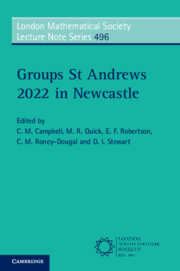Book contents
- Frontmatter
- Contents
- Introduction
- 1 Finite group schemes
- 2 Algorithms for polycyclic groups
- 3 The spread of finite and infinite groups
- 4 Discrete subgroups of semisimple Lie groups, beyond lattices
- 5 Complete reducibility and subgroups of exceptional algebraic groups
- 6 Axial algebras of Jordan and Monster type
- 7 An introduction to the local-to-global behaviour of groups acting on trees and the theory of local action diagrams
- 8 Finite groups and the class-size prime graph revisited
- 9 Character bounds for finite simple groups and applications
- 10 Generalized Baumslag-Solitar groups: a topological approach
- References
4 - Discrete subgroups of semisimple Lie groups, beyond lattices
Published online by Cambridge University Press: 21 November 2024
- Frontmatter
- Contents
- Introduction
- 1 Finite group schemes
- 2 Algorithms for polycyclic groups
- 3 The spread of finite and infinite groups
- 4 Discrete subgroups of semisimple Lie groups, beyond lattices
- 5 Complete reducibility and subgroups of exceptional algebraic groups
- 6 Axial algebras of Jordan and Monster type
- 7 An introduction to the local-to-global behaviour of groups acting on trees and the theory of local action diagrams
- 8 Finite groups and the class-size prime graph revisited
- 9 Character bounds for finite simple groups and applications
- 10 Generalized Baumslag-Solitar groups: a topological approach
- References
Summary
Discrete subgroups of $\SL(2,\R)$ are well understood, and classified by the geometry of the corresponding hyperbolic surfaces. Discrete subgroups of higher-rank semisimple Lie groups, such as $\SL(n,\R)$ for $n>2$, remain more mysterious. While lattices in this setting are rigid, there also exist more flexible, ``thinner discrete subgroups, which may have large and interesting deformation spaces, giving rise in particular to so-called higher Teichm\uller theory. We survey recent progress in constructing and understanding such discrete subgroups from a geometric and dynamical viewpoint.
- Type
- Chapter
- Information
- Groups St Andrews 2022 in Newcastle , pp. 118 - 190Publisher: Cambridge University PressPrint publication year: 2024
References
- 1
- Cited by

